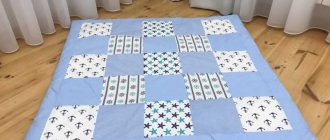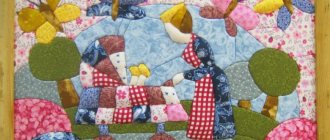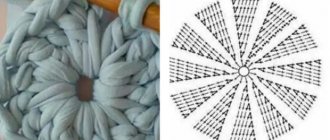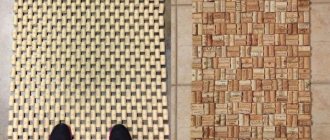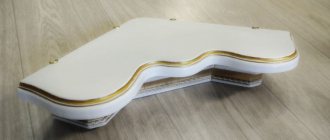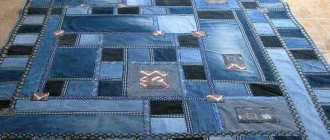Home / Interior furniture / Decor and creativity
3
Reading time: 5 minutes
A
A
Scraps and remnants of various fabrics are not garbage, but a real treasure in the hands of a needlewoman, which can be turned into amazingly beautiful and useful things, for example, rugs for a nursery, hallway or bathroom. There are so many ways to make rugs and rugs that you don’t even need to know how to sew and knit, you just need to choose the most convenient option for yourself.
DIY rugs made from scraps of fabric
After getting acquainted with the methods of making chair covers and sewing rugs, think about whether it is worth throwing away old T-shirts, jeans, towels, woolen sweaters and scarves. After all, all these things, even if they are shabby, with holes, faded in the sun, can be given a second life.
Patchwork fantasies
Bright rainbow rug
- Preparation of flaps Cutting continuous tape
- Connection without node
- Video - Crocheting a round rug from cut fabric strips
- Braid rug
- Video - Denim rugs
Preparation of flaps
Depending on the chosen technique for making the rug, scraps of fabric of different sizes and shapes may be required. It is better to select and cut the required amount in advance so as not to be distracted while working.
Preparing long strips of fabric for knitting or weaving a product can cause some difficulties: sewing them together is a long and tedious job. And if you tie them in knots, the rug will turn out rough and sloppy. But there are ways to avoid this.
Cutting continuous tape
This method is used when preparing fabric strips from old clothes: T-shirts, turtlenecks, T-shirts and even tights.
Step 1.
We cut off the rough bottom seam, the cuff of the sleeve or the toe part of the tights. For a T-shirt or turtleneck, cut off the top part right below the armholes.
Trimming seams
Step 2.
Place the product on a flat surface with the side seam facing you and cut it into strips of the required width, without cutting a couple of centimeters to the opposite seam.
Cutting strips
Step 3.
Thus, we cut the entire workpiece into fringe.
Workpiece cutting
Step 4.
We straighten the workpiece so that we can see the entire uncut part, and cut it not in a straight line, but at an angle, directing the scissors from one slot to the adjacent one on the other side of the product.
Cutting fabric
As a result, we get a closed ring, which to obtain a tape you just need to cut across one of the seams.
Blank for making a rug
Blanks can be wound into balls
Connection without node
If the length of the tape is not enough or you need to connect many short pieces with each other, the simple technique shown below will help you do this.
| Image | Description |
Step 1 | We cut small holes at the ends of adjacent strips that need to be connected. |
Step 2 | Place the strips on top of each other, aligning the slots. |
Step 3 | Pass the second end of the top strip through the slot from below and pull the entire strip through it. |
| Step 4 | Tighten the connection. If necessary, repeat these steps to further lengthen the tape. |
Advice. If scraps of fabrics of different thicknesses and densities are used, then thinner ones should be cut into strips of greater width to even out the thickness of the weaving.
Carpet of belts
Old belts will become an unusual design for the entrance area.
The rules for creating such an element are very simple:
- It is advisable to choose belts of the same length and width.
- If necessary, strips of leather are cut to the required size.
- The buckles can be cut off or left as an original decoration.
- Natural leather products and their imitations can also take part in the creation of a door carpet.
To make such a rug, it is enough to firmly connect the elements together. This can be done using small holes made with a small awl or nail and strong fishing line.
Knitted rugs from patches
From scraps joined into long ribbons, a rug can be crocheted, just as napkins are crocheted from ordinary yarn. True, for such work you need a large hook, 6-10 mm thick.
Begin work by tying a braid of 5-6 air loops, which are closed into a ring. Then the fabric is knitted in a spiral with double crochets, periodically knitting two stitches from one loop to increase the diameter. After each row, the work must be laid out on a flat surface to control the plane.
Crochet
Crocheting a rug
Video - Crocheting a round rug from cut fabric strips
Such a simple round rug does not require any special skill; even those who have picked up a crochet hook for the first time can knit it. If you have experience, you can create real masterpieces of any form.
Crochet rug
Handmade children's rug
Bright knitted rug
Multicolored rug
Carpet made of towels
A traditional fluffy rug made from terry towels will answer the question of how to make a rug for a bedroom or bathroom.
- To do this, terry fabric is cut into strips about 5 centimeters wide, and the simplest braid is woven from the resulting strips, which is then laid in a spiral. The adjacent layers are carefully stitched together.
- The manufacturing process is particularly simple and fast. So you can make a pleasant bedding for your feet in just an hour.
To make the product look more well-groomed, the edges of the strips can be pre-sewn together. This will help get rid of frayed threads and make the craft more dense.
Braided rugs
You can weave a rug in different ways, and to do this, the scraps again need to be joined into long strips.
Braid rug
This method is very simple, it does not require any tools or equipment other than a needle and thread.
Step 1.
Sew three patchwork strips together.
Sew three patchwork strips together
Step 2.
We braid them into a regular braid. It should turn out to be quite long, so the strips will have to be extended as you work.
Braiding
Step 3.
We secure the end of the braid with a pin and begin to roll it in a spiral on a flat surface.
Twisting a braid
Step 4.
We fasten each turn to the previous one on the reverse side, sewing it with threads.
Sewing a braid
Step 5.
You can do it differently: first twist the entire braid, and then carefully sew the turns in a spiral.
Making a rug
An oval rug is made in the same way.
Braided rug
Terry mat-braid
Curly rug made from braids
Rug made of towels
But if you need a rectangular shape, it is better to weave several braids of the same length, lay them close to each other and sew them in a straight line. And weave the ends with cord or sew on a typewriter.
Scheme for making a rectangular rug
Rectangular woven rug
Advice. Such a rug will hold its shape better if you add a lining to it on the back side.
The lining can be an old towel
Braided rug
To make such a rug you need to make a frame for weaving. Its size should be slightly larger than the desired size of the canvas. Nails with small heads are placed on two opposite sides or wooden pins are installed to secure the base. The distance between them is 2-2.5 cm.
Weaving frame
Advice. If you add another intermediate crossbar to the frame, which can be attached at different levels, you can make rugs of different sizes.
Step 1.
We begin work by securing the warp threads. This can be cord, twine, thick yarn, or scraps tied into a long ribbon. The end of the tape is tied to the upper corner stud, after which it is snaked around all the pins of the upper and lower crossbars in turn. You need to stretch the base well, but not too tightly.
Fastening the warp threads
Step 2.
Preparing working threads. They should not be too long so as not to make weaving difficult. It is better to attach the next strip as you shorten the previous one.
Preparing working threads
Step 3.
We begin weaving by alternately passing a strip of working thread over and under the stretched warp threads.
Let's start weaving
Step 4.
Having reached the end of the row, we wrap the working thread around the outer warp thread and continue weaving in the other direction.
Weaving from the edge
Step 5.
Every few rows, compact the fabric by pulling the woven rows up. To do this, you can use a special device in the form of a wooden fork or simply use your hands. The denser the weaving itself and the smaller the distance between the rows, the less noticeable the warp threads will be.
Thread compaction device
Step 6.
We make the required number of rows, periodically increasing the working thread or changing it to a strip of a different color.
Weaving a rug
Step 7
If the color of the working thread needs to be changed at the edge of the rug, it is cut close to it and hemmed, or the next strip is tied to the cut end, and the knot is left on the wrong side. But you can do it differently: tie the strips on the edge, leaving long tails. In this case, the edges of the rug will be fringed.
Weaving a rug with fringe
For reference. The fringe on the other two sides can also be done at once, if you do not wind the warp threads around the pins, but tie them to each pair with separate strips.
Chair cover with fringe
At the end of the work, the canvas is carefully removed from the nails.
You can complicate the weaving by taking two working threads instead of one at once, and interweaving them both with each other and with the warp threads.
How to weave a rug without a loom
Video - Rug made of shreds on a frame
You can also weave a round rug in a similar way. A hoop can serve as a frame for it.
Round wicker rug
The process of weaving a rug on a hoop
Homespun rugs
The well-known weaving principle is also often used in the manufacture of homemade patchwork rugs. The role of the machine will be performed by a wooden frame, slightly larger in size than the intended canvas. Small nails are placed on the top and bottom strips at a distance of about 2 cm from each other, and a base is pulled over them from the same strips that were prepared for creating the canvas or from twine, which must be strong.
Its end is tied to the first upper nail, pulled to the parallel lower one, then to the second upper one, filling the space between the slats. The strips are pulled between the warp threads row by row, from time to time compacting what is collected with your hands or using a special wooden fork.People often ask: how to weave a rug without a loom? The frame will be successfully replaced by a large sheet of cardboard. The cuts on opposite sides will act as nails, holding the warp threads. Further actions are the same as with the usual method.
You can use a plastic hoop with deep notches for weaving, stretch the warp along the diameter and lay the material in a circle. The difficulty is to lay the threads strictly between opposite points so that they intersect exactly in the middle.
Knotted rug
To make such a shaggy rug, you don’t need to sew the scraps into ribbons. They just need to be cut into strips 8-12 cm long, depending on how long the “pile” you want to get.
In addition to them, the work will require a crochet hook and a special mesh for carpets, which can easily be replaced with a synthetic construction mesh. The base of the desired shape and size is cut out of it.
Carpet mesh
Then the strips folded in half are slipped under the mesh, and their ends are pulled out to the front side on both sides of the cell wall using a hook. All that remains is to tie them with a strong knot.
Blanks from an old T-shirt
Stripes tied into knots
The longer the ropes, the fluffier the rug.
All grid cells are filled in the same way.
Using scraps of different colors, you can create patterns and ornaments from them according to a pre-designed scheme.
Soft patch rug
Heart shaped rug
DIY carpets using patchwork technique
The “patchwork” products are beautiful and original. Do-it-yourself patchwork style rugs from scraps of fabric are easy to make. To make them, follow the instructions:
- Prepare material - scraps of fabric, scraps, themed pieces with prints specially purchased in stores or on the Internet.
- Wash and steam new fabrics, starch and iron old scraps.
- Thick fabrics - tweed, gabardine, drape - are perfect for rugs.
- For a longer service life of the product, take a lining - it can be foam rubber, synthetic padding, batting or a thick carpet base.
- Bring all pieces of fabric to the same size and shape; use a template for this; no seam allowances are needed for dense materials.
- Take the base, stitch all the pieces of fabric onto it in a chaotic order or following certain patterns and images. Schemes for patchwork can be found in specialized magazines or on the Internet.
- Once you have mastered simple sewing, you can try making rugs with curved lines or complex patterns.
- A variation of patchwork is the knitted type, in which the patches are not sewn, but tied together.
- To obtain a soft, voluminous rug, you can use the quilting technique, in which 2 fabrics are sewn together, and a padding polyester is laid between them.
Patchwork pompom rugs
Very soft and cozy rugs are made from patchwork pompoms filled with holofiber, padding polyester or foam rubber. You don’t have to buy filler either - you can “get it” from old jackets, blankets and stray pillows.
The choice of patches depends on the purpose of the rug. For children, old knitted T-shirts and T-shirts in bright colors are best suited.
To work you need to prepare:
- a large number of scraps or old unnecessary knitwear;
- needle and thread;
- scissors;
- filler;
- thick fabric for the base;
- glue gun
Step 1.
We cut out circles of the same size from the knitwear according to the template. Their diameter should be approximately twice the intended diameter of the pom poms.
Cut out circles
Step 2.
Using a simple stitch, we quilt the blanks in a circle, stepping back a little from the edge.
Quilting the workpiece around the circumference
Step 3.
Place filler in the middle and tighten the thread. We get a soft ball.
Filling included inside
Step 4.
We make such balls from all the blanks.
Preparing pompoms
Step 5.
We cut out the base for the rug from the fabric and use a glue gun to sequentially glue patchwork pompoms to it. They can also be sewn on.
Attaching pompoms to the base
To make a similar rug for the bedroom, you can take a coarser and more wear-resistant fabric, and for the bathroom - old terry towels.
Rug made of pompoms
Old rugs and bedspreads of strict monochromatic colors will make an interesting rug in the shape of flowers or a clearing. If the fabric is thick and dense enough, you can even do without filler or use very little of it.
Rug "Polyanka"
Rug made of pompoms in the shape of a leopard skin
The manufacturing algorithm is the same, with minor nuances.
| Step, no. | Description |
1 | We cut out a base from the fabric in the shape of the future rug. From working fabric and scraps we cut out rounded oval and round shapes to create “stones”. We make them quite large. |
2 | We bend the edges of the blanks inward and sew them on the wrong side. If they are not voluminous enough, put a little synthetic padding inside. |
3 | We prepare the required number of parts so that they fill the entire area of the cut base. It is advisable to make “pebbles” of different textures, shapes and sizes to make the rug look more natural. |
4 | We lay out the blanks on the base in the required order and sew the adjacent ones together. |
| 5 | Sew the “pebbles” to the base fabric. |
6 | We especially carefully fasten all the parts around the perimeter of the rug together. |
7 | We cut out the backing from thick fabric according to the size of the resulting product, making small allowances for the hem. And we sew them together along the edge. |
"Stone" carpets
Despite their “hard” name, these rugs will give you a cozy and homely atmosphere.
They are made from:
- Fabric base;
- scraps of fabric,
- Sintepon or cotton wool.
Pieces of filler are placed in small patches (they can be of various sizes. In this case, the carpet will give the impression of the seabed or an uneven garden path).
The patches are sewn together in the manner of knots and sewn to the base. From multi-colored “pebbles” you can create an unusual pattern or put together a whole picture.
Rugs made from patchwork corners
This method is suitable only for craftswomen who are good at machine sewing.
Rug made of triangles
To make such unusual and very beautiful rugs you will need scraps of fabric of the same density.
| Step, no. | Description |
1 | We cut identical squares from the fabric with a side of about 10 cm and fold them twice diagonally. |
| 2 | We pin the resulting corners to the fabric, forming the middle of the rug. And we attach them along the edge using a typewriter. |
3 | We lay the next row so as to close the seam, shifting the corners relative to the ones already hemmed. |
| 4 | Having sewn the second row, we form the third and subsequent ones in the same way, gradually expanding the circle. |
5 | We attach the last row close to the edge and finish it with bias tape. |
In the example described, the corners of the patches look into the middle of the rug. But you can do the opposite: start sewing the triangles not from the center, but from the edge of the product, turning them outward. In this case, you will have to decorate the middle with a round patch.
From the scraps you can make not only corners, but also other shapes - petals, scales, beaks, etc.
Beautiful rug in the shape of a flower
Such different rugs are made from scraps of fabric and old things that no one wears anymore. Instead of adding to the amount of waste on the planet, you can put old things to good use, while decorating your home and saving money on buying rugs, pet bedding and kitchen stool covers.
Denim rug
Rugs made from old jeans
Carpet made of jeans
Thick, practically indestructible fabric will serve even after the death of your favorite pants or jacket. A small rug made from jeans with your own hands will decorate any room.
- To do this, denim items are cut into small rectangles, which are then sewn together.
- In this case, the frayed ends can be hidden on the wrong side or left as an unusual decoration for the rug.
- Pieces of fabric with thick seams can be used for edging the finished product.
- To make the carpet more comfortable, make two halves at once, lay a layer of synthetic padding inside and finally grind down the craft.
Patchwork lovers can make wonderful floor pictures from leftover denim fabric.
How to make a shaggy rug - secrets of craftsmanship
For those who prefer soft and fluffy rugs, this secret of craftsmanship will come in handy. It's also easy to do. To do this, you should cut things into short and thin strips. As a basis, you can take a regular mesh, which should be purchased at a sewing store. There you can also purchase special kits, which include a mesh, special strips, and instructions. Making a shaggy rug is also extremely simple and uncomplicated.
Making a rug with your own hands from unnecessary things is easy and not difficult, it is only important to use your imagination and imagination a little and you will succeed. And trash will turn into a necessary and practical thing
And after a few days you will be able to make a practical and necessary product for everyday life of any level of complexity, it all just depends on your desire and your skills.
Entrance door mat made of plastic bags: description, photo, diagram
The mat located at the front door should be made of washable materials. Every time you or your guests will wipe their feet on this rug, so you will have to wash it very often.
It is logical that the material for such a rug should be selected for practical reasons. Knitted or fabric rugs certainly look very beautiful, but they are completely unsuitable for these purposes.
One of the most suitable materials for making a door mat is plastic bags. This material has a number of advantages:
- A rug made from plastic bags is easy to care for. It is enough to rinse it in running water, after washing it with a brush and powder or soap.
- Plastic bags are inexpensive.
- In almost all houses there is an abundance of such material, and housewives simply do not know how to get rid of the accumulated bags.
- By making a rug, you will still save the environment, at least a little. After all, we know about the problem of environmental pollution with bags.
You can make a rug from plastic bags using a hook. First you need to make ribbons from plastic bags and wind them into balls. To do this, cut the plastic bags along the seams, roll them into ribbons about 1-1.5 cm wide. Then, using a thick hook, knit the rug according to the pattern you will see below.
Rug knitting pattern
Options for rugs made from crocheted bags can be seen below. In essence, these rugs are the same as those made from yarn. However, they are better suited for placement at the front door and are more wear-resistant.
DIY rug made from bags Rugs made from plastic bags
If you don't know how to crochet, you can make pom poms from plastic bags. This rug will be less practical than the previous one. But it will look beautiful. If you take bags of different colors, you can make a rug with patterns.
make a pompom like this:
- Cut the bags into long strips of the same size and width.
- Wrap many strips onto a paper base.
- Use scissors to cut from opposite edges.
- Tie the strips in the center with strong thread.
- Fluff the pompom.
Then glue the pompoms onto the base. Polyethylene pompoms can be used to form flowers and other designs.
Rug made from garbage bags
We invite you to watch a master class on making a rug from plastic bags.
So
Carpet weaving has always been and is a highly profitable occupation among all peoples, under any political system and economic system. A margin (rise) of 200-300% is an ordinary phenomenon in this business. But do not rush to get into the credit swamp to purchase equipment and start a cottage industry based on theory alone: the requirements of potential buyers for the quality of carpet products are also traditionally very high.
To get started, it wouldn’t hurt to watch a master class on making homespun carpets.
Video: making homespun rugs - master class
Then, get a carpet weaving loom. Simple and inexpensive, but suitable for the production of commercial-grade products. Its basis is a strong frame; wooden - from timber from 40x40 or plywood from 20 mm, pos. 1 in Fig. If you have an old window frame lying around somewhere, carpentry work is no longer necessary.
Weaving equipment from scrap materials for carpets
The following are guide pins for threads and pegs. Here, modernity is better than antiquity: push pins-markers with a long neck (item 2) are just what you need. For handicraft work, they have a number of advantages compared to steel and wooden pegs:
- Cheap per piece.
- Installed by female forces. Screwing in several hundred threaded steel pegs or installing the same number of wooden pegs is a job even for a hardy man, and even a child can push buttons into pine.
- They are easily rearranged, practically without damaging the wood.
- The size, if inserted close to each other, is just right for weaving rugs.
- By placing the pins in a checkerboard pattern, you can give the warp and/or weft to the fabric more tightly, and by placing them at intervals - less frequently.
- When installing pegs from buttons, both the thread and the plait or braid will pass as tightly as possible into the windows between the necks.
- Smooth, slippery necks of the buttons will ensure uniform tension of the fabric threads.
Your dearest believer can and should also be harnessed to make the machine: let him make a comb the entire width of the frame window for stuffing the weft from a wooden (preferably oak) block and pieces of knitting or bicycle needles. In extreme cases, you can stuff it with a fork, as described above, but with a comb the work will go faster and better.
Next is the shuttle. A fishing shuttle is not suitable for weaving nets; it is designed for rather complex manipulations of knitting knots. When weaving, you will have to turn it over all the time, and throw off the consumable loops, making movements with your fingers, which is very tiring in an already difficult weaving job. A salted and tanned fisherman who has just tied his net can be recognized by his crab-shaped hands. The smooth spool shuttle easily dives into a very dense base, but it also needs to be turned over, which slows down the work, and the manufacture will require high-quality materials and metal work.
For weaving rugs, the old-style handloom weaving shuttle is best suited. Its drawing is given above at pos. 3. Material – hard wood, plywood, hard plastic 2-4 mm thick. How the thread is wound onto this shuttle is shown in pos. 4. The consumable skein is thrown onto the beak with loops alternately on one side and the other. To remove the next loop, the shuttle is pushed back, it will come off the beak itself. This should be done when the shuttle is outside the base.
Finally, tying a new thread to the end. How to extend tapes and strands was described earlier. And the thread is tied with a simple weaving knot, pos. 5. There are other weaving knots, but for fairly thick and strong carpet thread, this is the most suitable.
Bottle cap rug
Cork rugs are very popular today, in particular, due to their good environmental performance. In addition, this accessory is lightweight and can be easily disinfected if necessary.
To create an original rug you will need several dozen corks, strong glue, a silicone mat as a moisture-resistant base, and a knife. Instructions on how to make an original rug with your own hands:
- All collected plugs must first be washed in warm water and soap (disinfection of the material).
- Each cork is cut in half along the long axis.
- All irregularities should be carefully sanded, for example, with sandpaper.
A layer of glue is applied to the silicone mat, and then the cut corks are laid cut side down.
If you have a sufficient amount of consumables and the proper creative approach, you can even form an original design on the surface of the rug. After the accessory has completely dried, you can apply 1-2 layers of sealant, which will prevent moisture from entering and destroying the rug.
